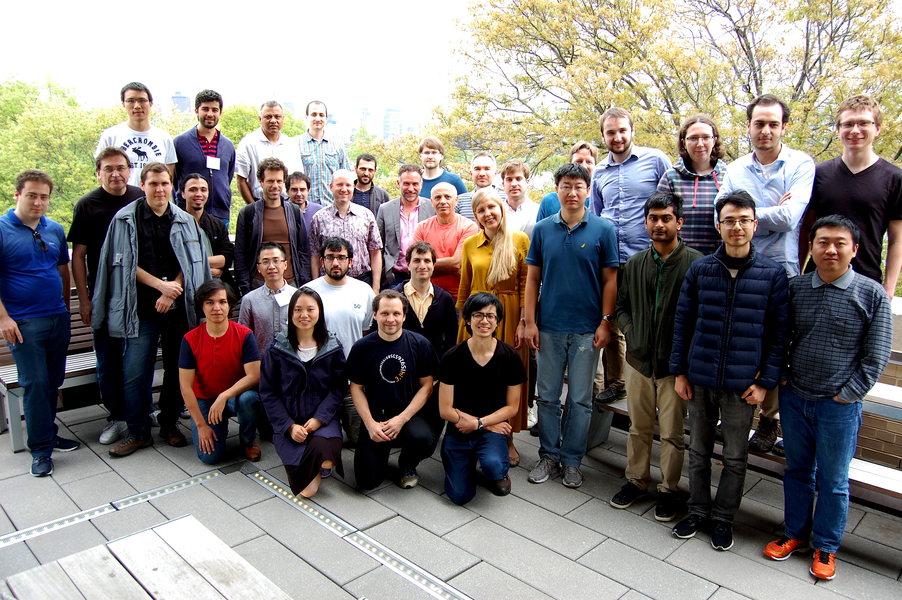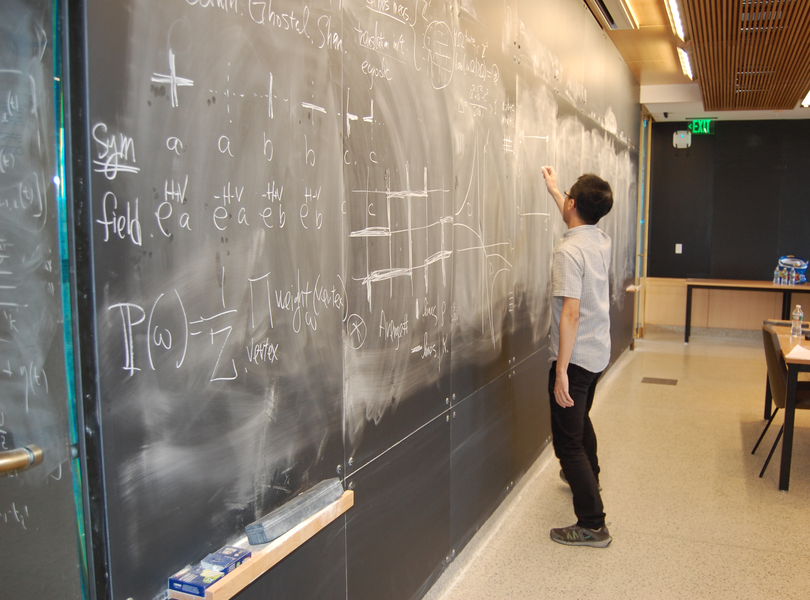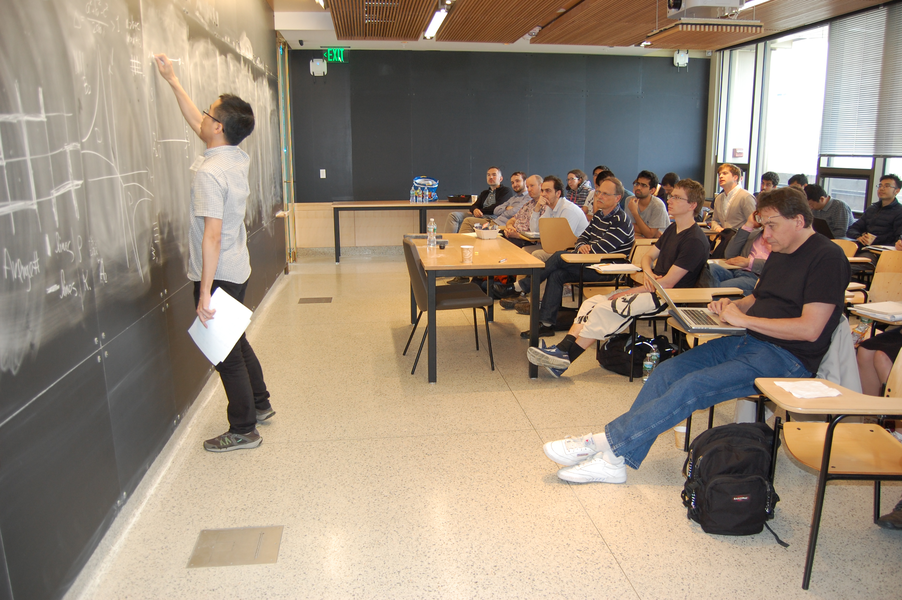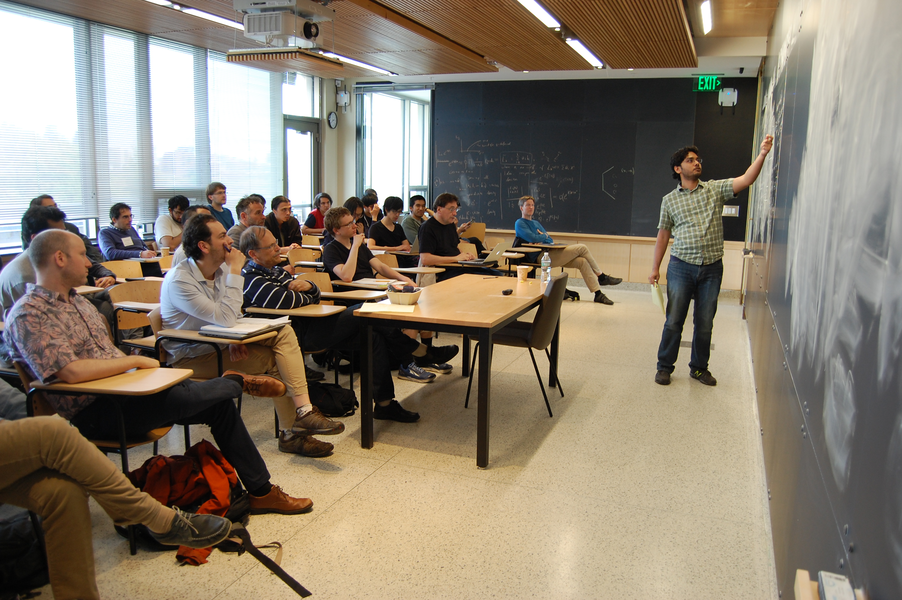Integrable Probability Boston 2018 (IntProb Boston)
May 14-18, 2018, MIT, Cambridge, MA
Location: 2-449
-
Participants
-
Conference Forum (login/password available at the conference)
Schedule
Monday, May 14
- 09.55 - 10.00 • Opening remarks
- 10.00 - 11.00 • Jeremy Quastel
TASEP and the KPZ fixed point
TBA - 11.30 - 12.30 • Patrik Ferrari
On the time-time correlations close to the characteristic line
We consider the time correlations for KPZ growth models in 1+1 dimensions and focus at the covariance of the time-time process for two space-time point close to the a characteristic line. We prove results claimed in arXiv:1602.0048 and extend them in a neighborhood of the characteristic line. We provide rigorous bounds on second order corrections when observation times are close (or far) from each other. Jointly with A. Occelli.Lunch - 2.30 - 3.30 • Atsuo Kuniba
Aspects of stationary states in multispecies exclusion and zero range processes
I shall survey combinatorial aspects of stationary states of the n-species totally asymmetric simple exclusion process (n-TASEP) and an n-species totally asymmetric zero range process (n-TAZRP) on L-site periodic chain. The topic will encompass matrix product formulas of quantum R matrices from tetrahedron equation, combinatorial R in crystal theory (theory of quantum groups at q=0), formulation of the Ferrai-Martin type algorithm and n-line processes by crystals, 3D interpretation of stationary probabilities, etc. n-TAZRP and n-TASEP turn out to be sister models associated with the symmetric and the antisymmetric tensor representations of U_q(\hat{sl}_L) and admit parallel description. (Joint work with M. Okado and S. Maruyama) - 4.00 - 5.00 • Guillaume Barraquand
Macdonald processes and KPZ equation in a half space
Macdonald processes are a powerful tool to study exactly solvable models in the KPZ universality class, such as directed polymers or ASEP and, as a limit, the KPZ equation. Most available results about these models are in a full space, for instance the KPZ equation on the real line R. This talk is about integrable versions of these models in a half-space and the KPZ equation on the half line R_+. We will explain why a half space variant of Macdonald processes seem to be the appropriate tool to study these half space models and probe the effect of boudaries in KPZ growth. Joint work with Alexei Borodin, Ivan Corwin and Michael Wheeler.
Tuesday, May 15
- 10.00 - 11.00 • Jeffrey Kuan
Algebraic constructions of Markov duality functions
Markov duality in spin chains and exclusion processes has found a wide variety of applications throughout probability theory. We review the duality of the asymmetric simple exclusion process (ASEP) and its underlying algebraic symmetry. We then explain how the algebraic structure leads to a wide generalization of models with duality, such as higher spin exclusion processes, zero range processes, stochastic vertex models, and their multi-species analogues. - 11.30 - 12.30 • Fabio Toninelli
A (2+1)-dimensional Anisotropic KPZ growth model with a rigid phase (joint work with S. Chhita, arXiv:1802.05493)
I will discuss 2+1 dimensional growth models in the Anisotropic KPZ (AKPZ) class and recall the relation, predicted by Wolf, between the Hessian of the speed of growth (as a function of the slope) and the critical exponents of height correlations in space and time. In particular, I will focus on an AKPZ model where, for a specific slope, the stationary state is "rigid" (O(1) fluctuations uniformly in space and time). The speed of growth turns out to be singular at the rigid slope (its second derivatives diverge). The growth process is defined via the shuffling algorithm for domino-tilings with two-periodic edge weights. - 2.30 - 3.30 • Zhipeng Liu
Multi-point distribution of periodic TASEP with general initial condition
In this talk, we will discuss our recent progress on the multi-time and multi-location distribution of periodic TASEP. For a general initial condition, we evaluate this distribution explicitly in terms of a multiple integral involving a Fredholm determinant. With some assumptions on the initial condition, we are able to compute the large time limit in the so-called relaxation time scale. This is joint with Jinho Baik. - 4.00 - 5.00 • Vadim Gorin
Telegraph equation from the six-vertex model
I will explain how a second order hyperbolic PDE, known as the telegraph equation, arises in the asymptotic of the height function of the six-vertex model. Homogeneous equation describes the limit shape in the system, and its stochastic inhomogeneous version governs the fluctuations.
Lunch
Wednesday, May 16
- 9.00 - 10.00 • Alexey Bufetov
A bijectivization of combinatorial identities behind integrable models
Abstract: An integrability of many stochastic models is related to the existence of non-trivial combinatorial identities behind them. Two sources of such connections are Cauchy identities in models coming from Macdonald processes, and the Yang-Baxter equation in vertex models of statistical mechanics. I will discuss an idea of bijectivization (or coupling) of these identities. Based on joint works with K. Matveev and L. Petrov. - 10.15 - 11.15 • Kurt Johansson
Two-time distribution in last-passage percolation
I will discuss a new approach to computing the two-time distribution in last-passage percolation with geometric weights. This can be interpreted as the correlations of the height function at a spatial point at two different times in the equivalent interpretation as a discrete polynuclear growth model. The new approach is rather close to standard random matrix theory (or determinantal point process) computations. I will give some background and also present some aspects of the computations involved. - 11.45 - 12.45 • Richard Kenyon
Dimers and circles
A circle pattern is an embedding of a planar graph in which the faces have circumscribed circles. We discuss relations between circle patterns for bipartite graphs and the dimer model, and in particular how local moves in the bipartite graph (cluster mutations) are related to Miquel moves for circle patterns. This is joint with Wei Yeung Lam (Brown).
Thursday, May 17
- 10.00 - 11.00 • Sylvain Prolhac
Brownian bridges for late time KPZ fluctuations in finite volume
Late time height fluctuations at the KPZ fixed point in finite volume can be expressed for arbitrary initial condition in terms of a deformation of the stationary eigenvector of TASEP, for which a matrix product solution is known. With periodic boundaries, a simpler reformulation of this matrix product representation allows to express the generating function of the height at late time in terms of conditional probabilities of non-intersecting Brownian bridges with exponentially distributed distances between the endpoints. Comparison with earlier exact Bethe ansatz asympotics leads to explicit expressions involving half-integer polylogarithms for specific initial conditions. Joint work with Kirone Mallick. - 11.30 - 12.30 • Satya Majumdar
Truncated linear statistics associated with the top eigenvalues of random matrices
Given an invariant random matrix ensemble with a joint distribution of eigenvalues $P(\lambda_1,\lambda_2,\ldots,\lambda_N)$, we study the distribution of a truncated linear statistics (TLS): $\tilde{L}=\sum_{n=1}^K f(\lambda_n)$ associated with the top $K$ ordered eigenvalues $\lambda_1>\lambda_2\ldots>\lambda_N$. Motivated by the statistical physics of fluctuating non-intersecting Brownian interfaces on a solid substrate, we focus on the Laguerre ensemble with $f(\lambda)=\sqrt{\lambda}$. Using a Coulomb gas method, we derive the distribution of $\tilde{L}$ in the limit when $K\to \infty$, $N\to \infty$ but with the fraction $0< \kappa= K/N<1$ fixed. We show that the constraint that $\tilde{L}= \sum_{n=1}^K f(\lambda_n)$ is fixed, leads to an infinite order phase transition in the underlying Coulomb gas. This transition corresponds to a change in the optimal charge density in the Coulomb gas, from a density supported on two disjoint intervals (for large $\tilde{L}$) to a density on a single interval (for small $\tilde{L}$). In the small $\tilde{L}$ phase, the density has a logaritmic divergence inside the bulk. Assuming that $f(\lambda)$ is monotonous, we show that these features arise for any random matrix ensemble and any TLS $f(\lambda)$, which makes our results robust and universal. - 2.30 - 3.30 • Mustazee Rahman
On shocks in the TASEP
Abstract: The TASEP, moving rightward, runs into traffic jams when the initial particle density to the left of the origin is smaller than the density to the right. The density function satisfies Burgers' equation and traffic jams correspond to its shocks. I will describe work with Jeremy Quastel on a specialization of the TASEP, where we identify joint fluctuations of particles at the shock by using determinantal formulae for correlation functions of TASEP and its KPZ scaling limit. The limit process is expressed in terms of GOE Tracy-Widom laws. - 4.00 - 5.00 • Li-Cheng Tsai
KPZ equation limit for the six vertex model
The Six Vertex (6V) model, initially introduced as a model for ice, is an integrable model for tiling in two dimensions. In this talk we consider symmetric and stochastic 6V models, and show that, under certain scaling into the ferroelectric/disordered phase critical point, fluctuations described by the Kardar--Parisi--Zhang (KPZ) equation arises.
Our approach utilizes the one- and two-point Markov duality enjoyed by the stochastic 6V model. One-point duality gives the (so-called) microscopic Hopf--Cole transform, and thereby exposes the connection to KPZ equation. On the other hand, two-point duality provides exact, analyzable formulas that help to establish certain self-averaging, which is the key step in the proof given the aforementioned transform.
Joint work with Ivan Corwin, Promit Ghosal, and Hao Shen
Lunch
Friday, May 18
- 9.00 - 10.00 • Leonid Petrov
Nonequilibrium particle systems in inhomogeneous space
I will discuss stochastic interacting particle systems in the KPZ universality class evolving in one-dimensional inhomogeneous space. The inhomogeneity means that the speed of a particle depends on its location. I will focus on integrable examples of such systems, i.e., for which certain observables can be written in exact form suitable for asymptotic analysis. Examples include a continuous-space version of TASEP (totally asymmetric simple exclusion process), and the pushTASEP (=long-range TASEP). For integrable systems, density limit shapes can be described in an explicit way. We also obtain asymptotics of fluctuations, in particular, around slow bonds and infinite traffic jams caused by slowdowns. - 10.10 - 11.10 •
Hao Shen
Open ASEP and KPZ equation
We consider the asymmetric simple exclusion process on the half line and on a bounded interval with sources and sinks, which is called Open ASEP. In the full line, Bertini and Giacomin (1997) proved convergence under weakly asymmetric scaling of the height function to the solution of the KPZ equation on the line. We show that under weakly asymmetric scaling of the sources and sinks as well, the half line height function converges to the KPZ equation on the positive real line with Neumann boundary condition at zero; and the bounded interval height function converges to the KPZ equation on the unit interval with Neumann boundary conditions on both sides. This result demonstrates how the KPZ equation arises at the triple critical point (maximal current / high density / low density) of Open ASEP. Our result is proved by applying microscopic Hopf-Cole transform. Joint work with Ivan Corwin.Coffee break with food - 11.50 - 12.50 •
Pierre Le Doussal
Large deviations for the KPZ equation
We describe recent results on the large deviations for the KPZ height both at late time and at short time. Using exact solutions the rate function at large time is obtained from a Coulomb gas calculation. The rate function at short time is also obtained for various initial conditions. The results are compared to high precision numerics on the directed polymer. Relations with results from the weak noise theory are also discussed. collaboration with Alexandre Krajenbrink, as well as (i) A. Hartmann, S. Majumdar, G. Schehr, A. Rosso, and (ii) I. Corwin, P. Ghosal, L-C Tsai. - 1.00 - 2.00 •
Alexei Borodin
Colored stochastic vertex models and their spectral theory
TBA





